Sabrimala is the holy abode of Sree Ayyappan; and the only way to reach this temple is by walking or trekking through the traditional trail. There are three trekking routes that lead to this temple. The Sabarimala traditional trekking path exudes charm with its scenic surroundings. This Hindu temple serves as the best example of the amalgamation of several religious traditions. It includes a unique tradition of offering prayer at the mosque of Vavar, a Muslim devotee of Ayyappan. This temple is the most famous and prominent among all the Sastha temples in Kerala.
Location
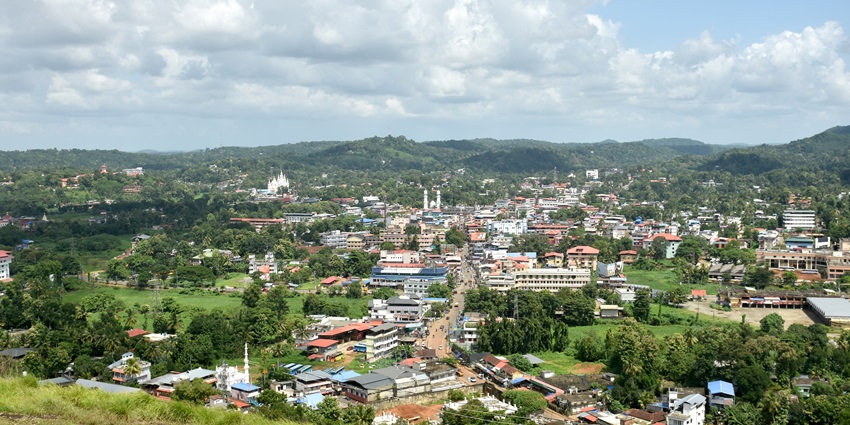
Photo: Prasanth Prakash / Wikimedia Commons
Located in the western ghats at a height of 914 metres above sea level, Sabarimala Temple is situated atop a hill in the village of Ranni-Perunad, Pathanamthitta district of Kerala.
Suggested Read: Top Kerala Temples That You Must Explore In God’s Own Country
How To Reach
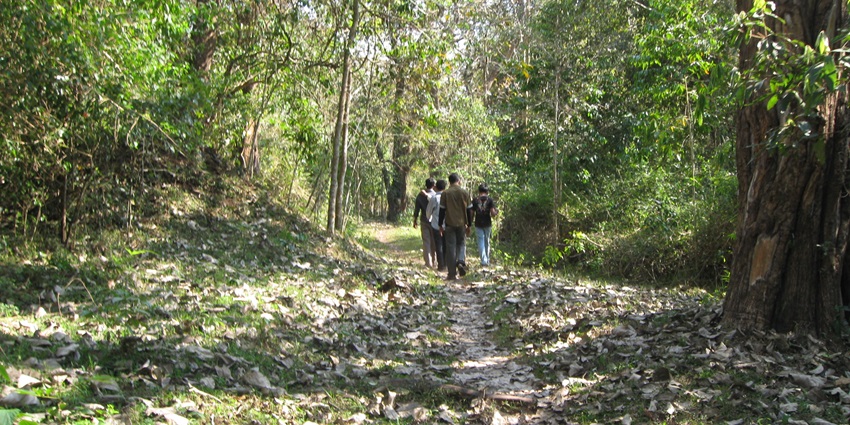
Photo: Kir360 / Wikimedia Commons / Image For Representation Only
Though you can reach the base of the temple via air, rail, or roadways, the only way to cover the Sabarimala traditional trekking path distance is by walking. There are three trekking routes from the base to reach the hilltop. The traditional route is from Erumeli to Pampa trail, and the shorter route is from Pamba to Sabarimala Temple. The easiest of all is the Chalakayam route. You can choose any route to reach this divine temple.
3 Sabarimala Traditional Trekking Paths
Sabarimala Temple is reachable by the following three trek routes. The traditional Erumeli trek route is the most-used one, and also the most challenging one.
1. The Erumeli Route
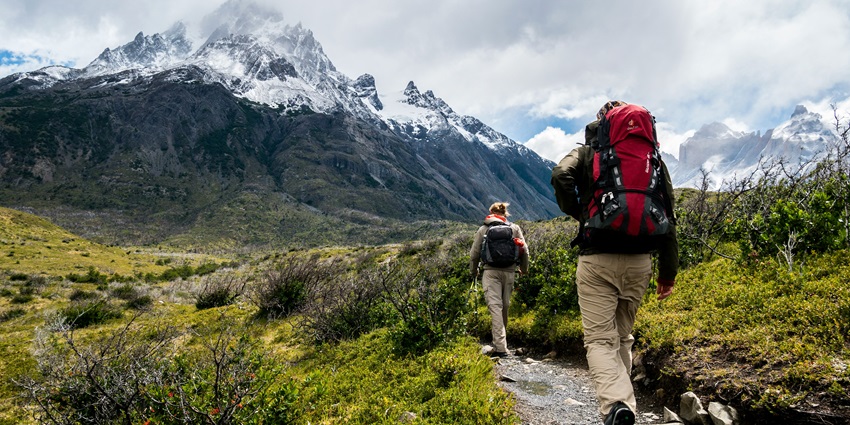
Photo: Toomas Tartes / Unsplash / Image For Representation Only
The traditional Sabarimala trekking path starts at Erumeli, where you can dress up as tribals and enjoy dancing with other devotees. Then, proceed to Petta Shri Dharmashasta Temple. After that, reach Perur Thodu, which is the last human-inhabited place before the dense forest begins. Beyond this, the arduous uphill trek to Azhutha Medu begins. You can take a dip in the Azhutha River, a tributary of the Holy Pamba.
Then, head towards Karimala Top, and seek blessings at the temples of Karimala Bhagavathi and Kochu Kadutha Swami. After that, proceed towards Pampa and Vazhukkum Para only to hop on to the 4-staged trek of Neelimala towards Sannidhanam. The trek from Apachimedu to Sabaripeetham is the most difficult in the entire journey. Marakootam is the point where the two routes meet.
Distance: 61 km
Duration: 2-3 days
Difficulty Level: Most challenging
Key Stops: Erumeli Town – Petta Shri Dharmashasta Temple – Perur Thodu – Azhutha Medu – Karimala Top – Pamba – Neelimala Trek (4-stage ascent) – Apachimedu to Sabaripeetham – Marakootam
Suggested Read: Trekking In Kerala
2. The Vandiperiyar Route
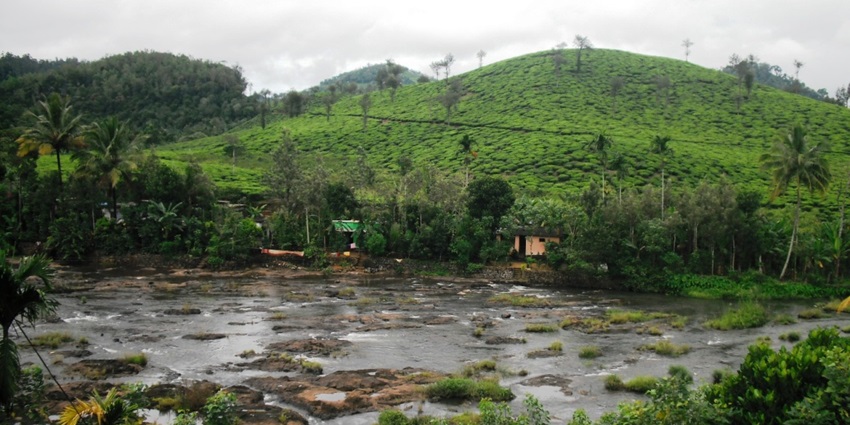
Photo: Jaseem Hamza / Wikimedia Commons
Vandiperiyar is 29 km from Sannidhanam, and this Sabarimala trek route is on the Kottayam-Kumili Road. It passes through Kozhikkanam, Uppupara, and Uralkuzhi Theertham. This is the most convenient route for the pilgrims, especially those coming from Tamil Nadu, touching Kumily. Private jeep and KSRTC bus services are available from Vandiperiyar and Kumily and run towards Uppara. After reaching Uppara, you need to trek through Pandithavalam, which is around 4 km to reach Ayyappa Sannidhanam.
Distance: 25 km
Duration: 1-2 days
Difficulty Level: Moderate to challenging
Key Stops: 94.4 km Milestone (Kottayam–Kumily Road) – Vandiperiyar – Kozhikkanam – Pullumedu – Uppupara – Uralkuzhi Theertham – Pandi Thavalam – Vallakadavu – Sannidhanam – Fina
3. The Chalakayam Route
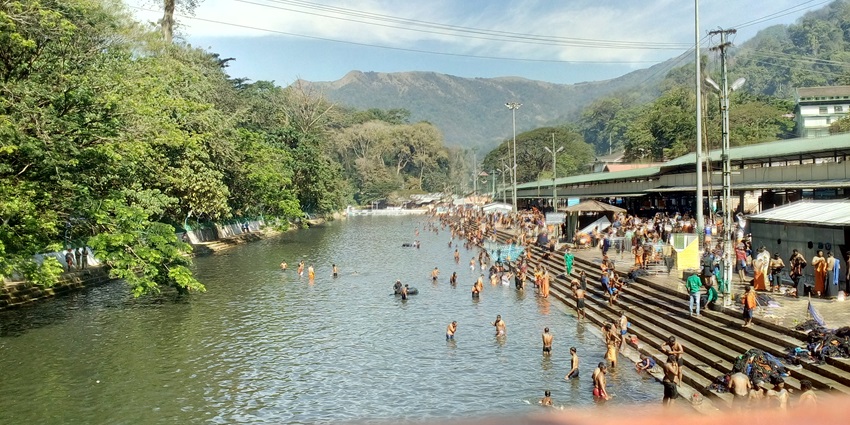
Photo: Gova4691 / Wikimedia Commons
The Chalakayam route is the easiest route to reach Ayyappa Sannidhanam. Chalakayam is near the River Pampa and is only 8 km from the main temple. This route from Pampa to Sabarimala Temple is also called the Neelimala route. You need to cross the Ganapathi Temple, Appachimedu, Sabari Peedom, and Marakkottam in order to finally reach Ayyappa Sannidhanam. It is advised to take short breaks in between even if the trek seems less challenging. There are a lot of pilgrim shelters and refreshment shops on the way.
Distance: 8 km
Duration: 0.5-1 day
Difficulty Level: Moderate
Key Stops: Chalakayam – Nilackal – Pamba – Neelimala – Sannidhanam
Suggested Read: Shiva Temples In Kerala
Where To Stay

Photo: Zak Chapman / Pexels / Image For Representation Only
Most trekkers stay at Pamba, which has guesthouses, lodges, and dharmashalas catering to pilgrims. For those starting from Erumeli, local lodges and homestays provide resting points before beginning the trek. Along Vandiperiyar and Chalakayam routes, short-term stays are available at forest rest huts or minor dharmashalas, but facilities are basic, so carrying sleeping mats and personal essentials is recommended. Booking ahead is essential during peak pilgrimage months due to high demand.
Where To Eat
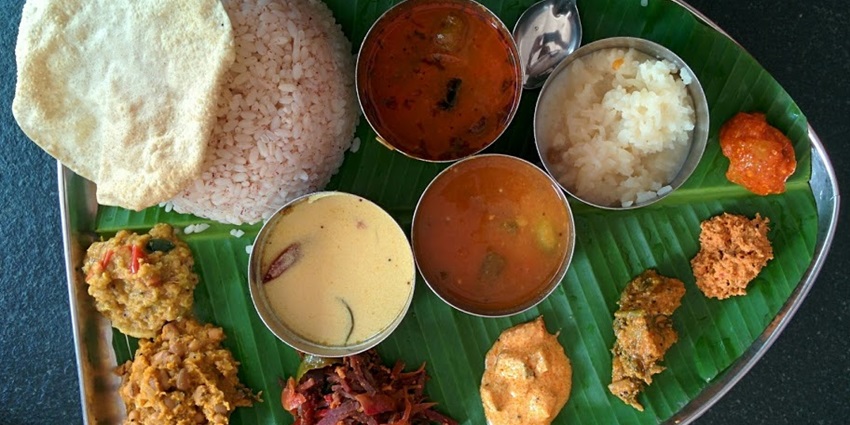
Photo: Raghavendra22 / Wikimedia Commons
Along the Erumeli route, pilgrims can access food at Kochumala, Karimala, and Erumeli town, where small dharmashalas and eateries provide vegetarian meals like rice with sambar, idli, dosa, and snacks. The Vandiperiyar and Chalakayam routes have very limited food options, so carrying dry fruits, energy bars, and sufficient water is essential. At Pamba, small restaurants and pilgrim canteens offer cooked meals for trekkers before the final ascent. Avoid consuming water directly from streams unless filtered or boiled.
Suggested Read: Best Food In Kerala
Best Time To Visit
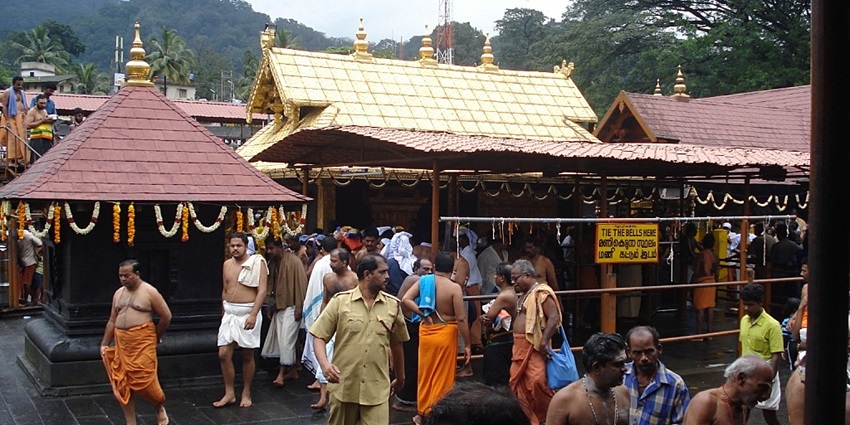
Photo: AnjanaMenon / Wikimedia Commons
The Sabarimala trekking routes are accessible year-round, but peak pilgrim activity occurs from November to January, when trails are dry and easier to navigate. Daytime temperatures range from 20°C to 28°C, with cool mornings and evenings, making trekking comfortable. Heavy monsoon periods (June–September) bring rain, slippery paths, and swollen rivers, especially on Vandiperiyar and Chalakayam routes, increasing the risk on steep and forested sections.
Tips For Travellers

Photo: Obsahovka Obsahovka / Pexels / Image For Representation Only
Planning your Sabarimala trek requires more than devotion. It demands preparation, awareness, and smart choices. These essential insights will help you navigate the trails safely.
1. Prepare Physically & Mentally: The trekking routes are moderate to challenging, so practice walking on hilly terrain and carrying a light backpack. Prepare yourself for 2-4 days of trekking, depending on the route.
2. Wear Appropriate Clothing & Gear: Use breathable clothes suitable for Kerala’s forest and hill climate. Trekking shoes are essential for rocky patches at Karimala (Erumeli route) and the Chalakayam route. Carry a lightweight backpack with a raincoat/poncho and trekking poles to walk on steep inclines.
3. Stay Hydrated & Healthy: Carry at least 2–3 litres of water per day; streams along Kochumala (Erumeli) or forest crossings (Vandiperiyar) are available, but boil or filter before drinking. Pack light snacks like dry fruits, energy bars, and a basic first-aid kit.
4. Respect Religious & Cultural Practices: Stop at Vavar Swamy Temple (Erumeli), local shrines along Vandiperiyar and Chalakayam routes, and perform prayers respectfully. Follow Vratham rituals (dress code, fasting, chants) if you are a devotee. Avoid littering and maintain a quiet atmosphere.
5. Trek Smart: Start early to avoid midday heat, utilise natural light and avoid fatigue on challenging segments like Karimala (Erumeli route) and rocky patches on the Chalakayam route. Stick to marked trails; crowds are heavy during November–January, so allow extra time.
Suggested Read: Places To Visit In Kerala With Family
Sabarimala traditional trekking path is the original path taken by Ayyappa, which is why a majority of the tourists and devotees prefer to take this path. Every stopover and landmark on this route holds history, which entices the devotees to take this path. The trek also offers mesmerising views of the surrounding forest. For a hassle-free experience, connect with TripXL, and visit this temple to experience both thrill and bliss at the same time.
Cover Photo: Vinayaraj / Wikimedia Commons


 WhatsApp
WhatsApp
 Twitter
Twitter









